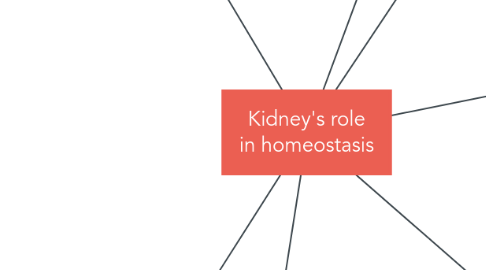
1. Regulation of hormones
1.1. Hormones
1.1.1. Antidiuretic hormone-ADH: Secreted from posterior pituitary gland in response to a rise in plasma osmolality
1.1.1.1. ADH binds to receptors on the surface of collecting duct cells in the nephron
1.1.1.2. The bound ADH causes water channels to open in the walls of the collecting ducts and water is reabsorbed into the blood, diluting the plasma and reducing the osmolarity to normal (Thomas 2014,, p.34)
1.1.1.2.1. Stimulation of osmoreceptors is reduced (negative feedback)
1.1.2. Aldosterone- steroid hormone secreted from the adrenal cortex
1.1.2.1. Aldosterone has effect on the distal tubule of the nephron
1.1.2.1.1. Activates sodium-potassium pumps ( Thomas, p.36)
1.1.2.1.2. The renin-angiotensin-aldosterone pathway (Thomas, 2014,p.35)
1.1.3. Atrial natriuretic peptide is released from cardiac atrial cells in response to an increased atrial stretch(Thomas,2014, p.34)
1.1.3.1. Inhibition of aldosterone secretion by the adrenal cortex
1.1.3.2. Reduction of renin release by kidney
1.1.3.3. Reduction of ADH release from the posterior pituitary
1.1.3.4. Vasodilation
2. Regulation of Arterial pressure
2.1. Kidney regulate blood pressure by maintaining glomerular hydrostatic pressure constant and GFR is maintained (Anna, 2015,p.43)
2.2. Kidney secretes hormone renin which has a direct effect on blood pressure via the renin-angiotensin pathway (Thomas,2014, p.35)
2.2.1. If blood pressure is raised by renal artery stenosis or atherosclerosis, impaired renal blood flow which stimulate release of renin and leads to hypertension
2.2.1.1. Sodium is the main extracellular cation and is related to extracellular volume (Thomas, 2014, p. 33)
2.2.1.2. Health education to control smoking and alcohol, healthy eating and regular exercise for weight control
3. Regulation of water and electrolytes balance
3.1. Kidney regulates body water with formation of a dilute or concentrated urine (Anna, 2015, p. 44)
3.1.1. In Dehydration, total loss of body fluid leads to decrease in circulating fluid volume and increase in osmolarity and triggers the thirst mechanism so response to drink fluid to restore fluid balance (McLafferty, 2014)
3.1.2. When fluid level is low, blood pressure low and renin release from kidney(McLafferty)
3.1.3. An increase in sodium content lead to increase in extracellular fluid volume and leads to hypertension and oedema ( Thomas, 2014,p. 33)
4. Filtration:Filtrate of blood formed at Bowman's capsule ( Thomas,2014, p. 21)
4.1. Passive transport of filtration of water and small molecules from the plasma into Bowman's capsule.
5. Acid base balancing
5.1. The kidney regulate acid-base balance by filtering bicarbonate HCO3- reabsorption and excretion of H+ into urine. This process occur in Proximal convoluted tubule, Distal tubule and collecting duct.(Anna, 2015, p. 42).
5.1.1. The kidneys can excrete urine with a pH between 4.5 and 8 (Anna, 2015, p.42)
5.1.1.1. Acidic urine is formed when the kidney excrete more H+ than HCO3- . Alkaline urine is formed when the kidney excrete more HCO3- than H+
5.1.1.2. Following reaction C02 + H2O - H2CO3 - H+ + HCO3- generated in plasma.
5.1.1.2.1. The bicarbonate ion concentration is controlled by the kidneys and PCO2 is controlled by the Lungs.
5.1.1.2.2. The H+ is secreted back into the lumen and the bicarbonate ion diffuses into the blood.
6. Removal of waste products through urine formation
6.1. Nephron-Tube like structure where urine is formed contains Renal Corpuscle, Proximal convoluted tubule (PCT), Distal convoluted tubule(DCT), Loop of Henle, and collecting ducts (Thomas 21)
6.1.1. Reabsorption and Secretion occur at Proximal tubule, Loop of Henle, Distal tubule and Collecting ducts (Thomas, 2014, p. 21)
6.1.1.1. Proximal tubule- Reabsorb Na. K+, Amino Acids, urea, Water , Glucose Secrete- H+, foreign substances
6.1.1.2. Loop of Henle- Concentration of urine Reabsorb water, Na+
6.1.1.3. Distal tubule- Reabsorb Na+, Water( needs ADH), HCO3- Secrets K+,H+, NH3+, Urea, some drugs
6.1.1.4. Collecting ducts- Reabsorb water( needs ADH), Reabsorb or Secrete-Na+,K+,H+,NH3+ inal concentration of urine
6.2. Excretion: Removal of water and solutes from the body ( Thomas, 2014, p. 21)
6.2.1. Eliminating waste products of metabolism -nitrogenous wastes, urea, from protein catabolism and uric acid, from nucleic acid metabolism Eliminating most toxins and other foreign substances that are produced by the body or ingested such as pesticides, drugs and food additives.
7. Glucose maintenance -maintaining glucose homeostasis
7.1. Gluconeogenesis (Liver and Kidney)
7.1.1. Generation of glucose from glucogenic aminoacids, triglycerides, pyruvate and lactate
7.1.1.1. Essential in regulation of acid base balance
7.1.1.2. Provide glucose when dietary intake is insufficient
7.1.1.3. Degradation of glycogen and fatty acid catabolism
7.2. Glucose uptake and utilization
7.2.1. Uptake of glucose from circulation to satisfy energy needs
7.2.1.1. Most uptake of glucose occurs in tissue that do not require insulin like brain, GI
7.3. Glucose reabsorption
7.3.1. Tubular reabsorption of glucose by facilitated diffusion in proximal tubule (Thomas, 2014, p.30).
7.3.1.1. In hyperglycemia, kidney play an important role in glucose reabsorption
